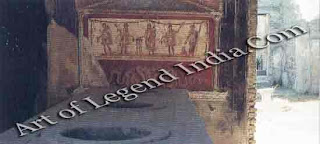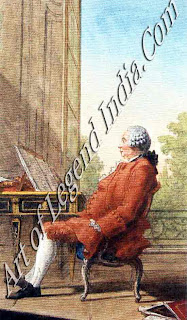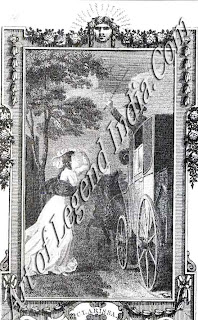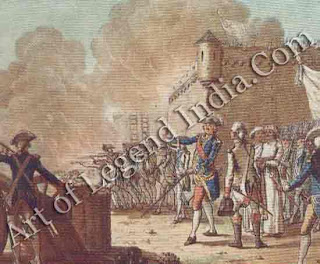A Year in the Life 1748
This
was a year in which the long-awaited general peace was made between the
European powers at Aix-la-Chapelle and in which Hogarth was jailed in France as
an English spy. More profound and enduring in their impact, however, were the
tremendous achievements of 1748 in the fields of art and science.
The
peace settlement of 1748 which ended the War of the Austrian Succession allowed
Hogarth to visit France, where his drawings of the fortifications at Calais
landed him in prison on suspicion of being an English agent. He revenged
himself in characteristic style by painting Calais Gate, also known as The
Roast Beef of Old England in which the John Bullish portrayal of Frenchmen as
scrawny starvelings gave splendid expression to the British prejudice that lasted
well into the following century.
 Finalized
in October at Aix-la-Chapelle, the peace put an end to a complicated and futile
conflict of major powers which had involved most European states from Spain and
Sardinia in the west to the newly emergent great power of Russia in the east.
The most solid gains were made by Frederick the Great of Prussia, who kept the
province of Silesia which he had snatched from Maria Theresa in 1741 when her
title to the Habsburg dominions was under threat. Although the Austrian Queen's
rights under the Pragmatic Sanction were now universally recognized and her
husband had been elected to the office of the Holy Roman Emperor as Francis I,
Maria Theresa still hoped to revenge herself on Prussia and recover Silesia.
Britain and France accepted a restoration of the status quo but the stage had
been set for their struggle for mastery in North America and India.
Finalized
in October at Aix-la-Chapelle, the peace put an end to a complicated and futile
conflict of major powers which had involved most European states from Spain and
Sardinia in the west to the newly emergent great power of Russia in the east.
The most solid gains were made by Frederick the Great of Prussia, who kept the
province of Silesia which he had snatched from Maria Theresa in 1741 when her
title to the Habsburg dominions was under threat. Although the Austrian Queen's
rights under the Pragmatic Sanction were now universally recognized and her
husband had been elected to the office of the Holy Roman Emperor as Francis I,
Maria Theresa still hoped to revenge herself on Prussia and recover Silesia.
Britain and France accepted a restoration of the status quo but the stage had
been set for their struggle for mastery in North America and India.

However
of greater note perhaps were the cultural and scientific events of 1748. The
Swiss Leonhard Euler, at the height of his powers, published a pioneering
introduction to analytical mathematics. Sociology and the study of comparative
institutions were effectively founded by L'Esprit des Lois (The Spirit of the
Laws), in which the French thinker Montesquieu made the first sustained attempt
to describe the way in which societies are shaped by climate, history, religion
and other factors. In Britain, the first part of David Hume's Enquiry
concerning Human Understanding appeared. Hume, a Scot, is still regarded as
Britain's greatest philosopher, and the radical scepticism of his Enquiry was
to shock both rational and religious thinkers, since it denied the possibility
of certainty.
18th CENTURY SOAP OPERA
 Another
Scot, Tobias Smollett, made his literary debut with the novel Roderick Random,
a typically rude, racy work, peopled with a gallery of entertaining grotesques.
The sensation of the year, however, was a million-word story by an elderly
ex-printer. Samuel Richardson's Clarissa is probably the longest novel in
English. Nevertheless the book was to be read avidly all over the civilized
world. Richardson's achievement was to bring a new range of psychological
perceptions to the description of human behaviour but his contemporary
popularity probably owed more to another of Clarissa's qualities its excellence
as soap opera. Through obstacles, hesitations and changes of fortune Clarissa
is pursued by the macho Lovelace. Even when the pursuit ends shockingly in rape
there is a twist for Lovelace offers marriage, a proposal that is followed by a
further twist Clarissa refuses. . . and dies.
Another
Scot, Tobias Smollett, made his literary debut with the novel Roderick Random,
a typically rude, racy work, peopled with a gallery of entertaining grotesques.
The sensation of the year, however, was a million-word story by an elderly
ex-printer. Samuel Richardson's Clarissa is probably the longest novel in
English. Nevertheless the book was to be read avidly all over the civilized
world. Richardson's achievement was to bring a new range of psychological
perceptions to the description of human behaviour but his contemporary
popularity probably owed more to another of Clarissa's qualities its excellence
as soap opera. Through obstacles, hesitations and changes of fortune Clarissa
is pursued by the macho Lovelace. Even when the pursuit ends shockingly in rape
there is a twist for Lovelace offers marriage, a proposal that is followed by a
further twist Clarissa refuses. . . and dies.
A
different kind of surprise had been recorded a few years earlier by the
dilettante Horace Walpole on the Grand Tour.
'We
have seen something today that I am sure you never read of, and perhaps never
heard of. Have you heard of a subterranean town? A whole Roman town with all
its edifices remaining underground' Walpole was referring to Herculaneum in
Southern Italy a discovery which was soon eclipsed by that of the far larger
city of Pompeii. Like Herculaneum, Pompeii had been buried by mud and lava
after the great eruption of Vesuvius in AD 79. In revealing so much of the
Roman way of life, Roman decorative art and Roman wall paintings, the
excavation of Pompeii which began in 1748 gave a tremendous new impetus to the
worship of 'Antiquity', and was largely responsible for the development of the
great European style that dominated the late 18th century Neo-Classicism.
Writer
– Marshall Cavendish
 Finalized
in October at Aix-la-Chapelle, the peace put an end to a complicated and futile
conflict of major powers which had involved most European states from Spain and
Sardinia in the west to the newly emergent great power of Russia in the east.
The most solid gains were made by Frederick the Great of Prussia, who kept the
province of Silesia which he had snatched from Maria Theresa in 1741 when her
title to the Habsburg dominions was under threat. Although the Austrian Queen's
rights under the Pragmatic Sanction were now universally recognized and her
husband had been elected to the office of the Holy Roman Emperor as Francis I,
Maria Theresa still hoped to revenge herself on Prussia and recover Silesia.
Britain and France accepted a restoration of the status quo but the stage had
been set for their struggle for mastery in North America and India.
Finalized
in October at Aix-la-Chapelle, the peace put an end to a complicated and futile
conflict of major powers which had involved most European states from Spain and
Sardinia in the west to the newly emergent great power of Russia in the east.
The most solid gains were made by Frederick the Great of Prussia, who kept the
province of Silesia which he had snatched from Maria Theresa in 1741 when her
title to the Habsburg dominions was under threat. Although the Austrian Queen's
rights under the Pragmatic Sanction were now universally recognized and her
husband had been elected to the office of the Holy Roman Emperor as Francis I,
Maria Theresa still hoped to revenge herself on Prussia and recover Silesia.
Britain and France accepted a restoration of the status quo but the stage had
been set for their struggle for mastery in North America and India.  Another
Scot, Tobias Smollett, made his literary debut with the novel Roderick Random,
a typically rude, racy work, peopled with a gallery of entertaining grotesques.
The sensation of the year, however, was a million-word story by an elderly
ex-printer. Samuel Richardson's Clarissa is probably the longest novel in
English. Nevertheless the book was to be read avidly all over the civilized
world. Richardson's achievement was to bring a new range of psychological
perceptions to the description of human behaviour but his contemporary
popularity probably owed more to another of Clarissa's qualities its excellence
as soap opera. Through obstacles, hesitations and changes of fortune Clarissa
is pursued by the macho Lovelace. Even when the pursuit ends shockingly in rape
there is a twist for Lovelace offers marriage, a proposal that is followed by a
further twist Clarissa refuses. . . and dies.
Another
Scot, Tobias Smollett, made his literary debut with the novel Roderick Random,
a typically rude, racy work, peopled with a gallery of entertaining grotesques.
The sensation of the year, however, was a million-word story by an elderly
ex-printer. Samuel Richardson's Clarissa is probably the longest novel in
English. Nevertheless the book was to be read avidly all over the civilized
world. Richardson's achievement was to bring a new range of psychological
perceptions to the description of human behaviour but his contemporary
popularity probably owed more to another of Clarissa's qualities its excellence
as soap opera. Through obstacles, hesitations and changes of fortune Clarissa
is pursued by the macho Lovelace. Even when the pursuit ends shockingly in rape
there is a twist for Lovelace offers marriage, a proposal that is followed by a
further twist Clarissa refuses. . . and dies. 












0 Response to "British Great Artist William Hogarth - A Year in the Life 1748 "
Post a Comment